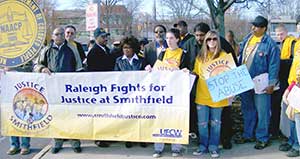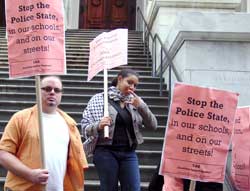WW speaks to Willie 'JR' Fleming
Workers World newspaper recently interviewed Willie “JR” Fleming, a member of the Coalition to Protect Public Housing and chair of the Hip Hop Congress Community Development Chapters.
The Hip Hop Congress has 29 chapters nationwide. In Chicago, they have chapters at Columbia College, Loyola University, Morgan Park High School and University of Illinois at Chicago, and the Cabrini Green community.
Its Web site, www.hiphopcongress.com, describes the congress as “a 501(c3) non-profit corporation that uses hip hop culture to inspire social and civic action, and cultural diversity amongst young people.”
JR told WW: “Predominantly before, the Congress was basically set up in institutions like universities, affluent neighborhoods and certain high schools. Our vision was to change that, and put it in more local colleges, community-based colleges, communities where there’s a lot of African-American or urban population.
“The element of the Congress that we represent is activism, knowledge—I guess another word for that would be advancement of the Congress itself, or Hip Hop itself. By using Hip Hop as a platform or a bridge to get not only artists to be accountable and socially conscious to what’s going on, but also the community.”
He explained: “Music has always been a platform to unite the people, so we use Hip Hop as one of them tools to unite the people, educate them, and also at the same time, entertain them, or as some people would call, edutain, our people. There has always been a plight in various communities, a lot of social ills exist, a lack of social services, social injustices. So Hip Hop has become a platform to unite these people. We utilize that to the utmost. “
Fighting police brutalityJR led the Cabrini Green chapter of the HHC in an activist, struggle oriented direction. That was evident in the militant protests at Cabrini Green, organized under the leadership of the Hip Hop Congress, after the Aug. 7 shooting last year of Ellis Woodland, Jr., a 13-year-old African-American.
Woodland was shot three times by police. The killing took place in the North Side Cabrini-Green public housing development.
JR said: “I mean, make no mistake about it, he was shot three times, shot at four, he was hit three times by large caliber firearms. So their intention wasn’t to wound him, disarm him, or anything of that nature. Their intention was to take him out.”
First, police claimed the youth had a gun. Then, it became a BB gun. His father, Ellis Woodland Sr., publicly stated that neither he nor his mother ever purchased a BB gun for his son.
The shooting outraged the Cabrini Green community. Several days after the shooting, HHC organized a demonstration against police brutality in front of the police station at 1160 N. Larabee in the heart of Cabrini Green.
“We went around with the bullhorn of course to hype the people,” he said. “Word travels fast in this community, you know. Hip Hop Alliance played a role, Coalition to Protect Public Housing played a role.
“A lot of residents over here already know what’s going on. You know, this police shooting had more or less something to do with community development more than anything.”
There is a rising wave of gentrification of Cabrini Green. It is built on some of the most valuable land in Chicago and borders on one of its most expensive neighborhoods—the “Gold Coast.”
The police response was more racism and violence. Cops at the protest were heard taunting a 17-year-old Cabrini Green resident, Maurice Taylor. After he verbally confronted an officer, Taylor reported that cops threatened him. On Aug. 13, Taylor was stopped and viciously beaten by the cops.
“It’s just the nature of the treatment of the people” by the cops, JR said. “They feel that the people have been displaced out this community, population is dwindling, and they don’t have too many rights, where the people don’t really care about what’s going on around them. We say we beg to differ.
“We saw the results of the marches. After the shooting occurred, a lot of people, when they got out there, they wasn’t just really angry at the police, they was angry at politicians. They was angry at the mayor. They was angry at the Housing Authority. For a lot of people already know the reason behind that shooting stems from the gentrification of this neighborhood, or the urban cleansing of this community.
“So the people have realized that these are just tactics and ploys to make people want to leave this community, quicker than they need be.
“You know, everybody have a right to adequate housing,” HR concluded. “[T]he basic cutting of the budget for the housing problem is a crime against humanity. It’s plain and simple. That’s creating an atrocity. So until the people wake up, we’re going to have these problems.”
Articles copyright 1995-2007 Workers World. Verbatim copying and distribution of this entire article is permitted in any medium without royalty provided this notice is preserved.


 Smithfield workers " border="1">
Smithfield workers " border="1"> 

